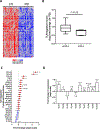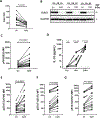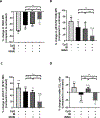TLR Signaling Is Activated in Lymph Node-Resident CLL Cells and Is Only Partially Inhibited by Ibrutinib
- PMID: 30498085
- PMCID: PMC6342512
- DOI: 10.1158/0008-5472.CAN-18-0781
TLR Signaling Is Activated in Lymph Node-Resident CLL Cells and Is Only Partially Inhibited by Ibrutinib
Abstract
Chronic lymphocytic leukemia (CLL) is a malignancy of mature B cells driven by B-cell receptor (BCR) signaling and activated primarily in the lymph node. The Bruton's tyrosine kinase (BTK) inhibitor ibrutinib effectively inhibits BCR-dependent proliferation and survival signals and has emerged as a breakthrough therapy for CLL. However, complete remissions are uncommon and are achieved only after years of continuous therapy. We hypothesized that other signaling pathways that sustain CLL cell survival are only partially inhibited by ibrutinib. In normal B cells, Toll-like receptor (TLR) signaling cooperates with BCR signaling to activate prosurvival NF-κB. Here, we show that an experimentally validated gene signature of TLR activation is overexpressed in lymph node-resident CLL cells compared with cells in the blood. Consistent with TLR activation, we detected phosphorylation of NF-κB, STAT1, and STAT3 in lymph node-resident CLL cells and in cells stimulated with CpG oligonucleotides in vitro. CpG promoted IRAK1 degradation, secretion of IL10, and extended survival of CLL cells in culture. CpG-induced TLR signaling was significantly inhibited by both an IRAK1/4 inhibitor and ibrutinib. Although inhibition of TLR signaling was incomplete with either drug, the combination achieved superior results, including more effective inhibition of TLR-mediated survival signaling. Our data suggest an important role for TLR signaling in CLL pathogenesis and in sustaining the viability of CLL cells during ibrutinib therapy. The combination of ibrutinib with a TLR pathway inhibitor could provide superior antitumor activity and should be investigated in clinical studies. SIGNIFICANCE: CLL relies on the concomitant cooperation of B-cell receptor and Toll-like receptor signaling; inhibition of both pathways is superior to inhibition of either pathway alone. GRAPHICAL ABSTRACT: http://cancerres.aacrjournals.org/content/canres/79/2/360/F1.large.jpg.
©2018 American Association for Cancer Research.
Conflict of interest statement
Conflicts of Interest
A. Wiestner reports receiving commercial research grants from Acerta Pharma and Pharmacyclics, an Abbvie Company. No potential conflicts of interest were disclosed by the other authors.
Figures






Similar articles
-
Ibrutinib inhibits BCR and NF-κB signaling and reduces tumor proliferation in tissue-resident cells of patients with CLL.Blood. 2014 May 22;123(21):3286-95. doi: 10.1182/blood-2014-02-548610. Epub 2014 Mar 21. Blood. 2014. PMID: 24659631 Free PMC article. Clinical Trial.
-
Expression of functional sphingosine-1 phosphate receptor-1 is reduced by B cell receptor signaling and increased by inhibition of PI3 kinase δ but not SYK or BTK in chronic lymphocytic leukemia cells.J Immunol. 2015 Mar 1;194(5):2439-46. doi: 10.4049/jimmunol.1402304. Epub 2015 Jan 28. J Immunol. 2015. PMID: 25632006 Free PMC article.
-
Functional and clinical relevance of VLA-4 (CD49d/CD29) in ibrutinib-treated chronic lymphocytic leukemia.J Exp Med. 2018 Feb 5;215(2):681-697. doi: 10.1084/jem.20171288. Epub 2018 Jan 4. J Exp Med. 2018. PMID: 29301866 Free PMC article.
-
Targeted therapy in chronic lymphocytic leukemia: past, present, and future.Clin Ther. 2013 Sep;35(9):1258-70. doi: 10.1016/j.clinthera.2013.08.004. Clin Ther. 2013. PMID: 24054703 Free PMC article. Review.
-
Bruton tyrosine kinase inhibitor ibrutinib (PCI-32765).Leuk Lymphoma. 2013 Nov;54(11):2385-91. doi: 10.3109/10428194.2013.777837. Epub 2013 Aug 28. Leuk Lymphoma. 2013. PMID: 23425038 Review.
Cited by
-
Dual stimulation by autoantigen and CpG fosters the proliferation of exhausted rheumatoid factor-specific CD21low B cells in hepatitis C virus-cured mixed cryoglobulinemia.Front Immunol. 2023 Feb 8;14:1094871. doi: 10.3389/fimmu.2023.1094871. eCollection 2023. Front Immunol. 2023. PMID: 36845129 Free PMC article.
-
The Immunomodulatory Functions of BTK Inhibition in the Central Nervous System.J Inflamm Res. 2022 Nov 24;15:6427-6438. doi: 10.2147/JIR.S389958. eCollection 2022. J Inflamm Res. 2022. PMID: 36452053 Free PMC article. Review.
-
MYD88 Mutations: Transforming the Landscape of IgM Monoclonal Gammopathies.Int J Mol Sci. 2022 May 16;23(10):5570. doi: 10.3390/ijms23105570. Int J Mol Sci. 2022. PMID: 35628381 Free PMC article. Review.
-
Ibrutinib sensitizes CLL cells to venetoclax by interrupting TLR9-induced CD40 upregulation and protein translation.Leukemia. 2023 Jun;37(6):1268-1276. doi: 10.1038/s41375-023-01898-w. Epub 2023 Apr 26. Leukemia. 2023. PMID: 37100883 Free PMC article.
-
A spheroid model that recapitulates the protective role of the lymph node microenvironment and serves as a platform for drug testing in chronic lymphocytic leukemia.Hemasphere. 2025 Jul 7;9(7):e70170. doi: 10.1002/hem3.70170. eCollection 2025 Jul. Hemasphere. 2025. PMID: 40625531 Free PMC article.
References
-
- Sun C, Wiestner A. Prognosis and therapy of chronic lymphocytic leukemia and small lymphocytic lymphoma. Cancer Treat Res 2015;165:147–75 - PubMed
-
- Damle RN, Wasil T, Fais F, Ghiotto F, Valetto A, Allen SL, et al. Ig V gene mutation status and CD38 expression as novel prognostic indicators in chronic lymphocytic leukemia. Blood 1999;94:1840–7 - PubMed
-
- Hamblin TJ, Davis Z, Gardiner A, Oscier DG, Stevenson FK. Unmutated Ig V(H) genes are associated with a more aggressive form of chronic lymphocytic leukemia. Blood 1999;94:1848–54 - PubMed
Publication types
MeSH terms
Substances
Grants and funding
LinkOut - more resources
Full Text Sources
Research Materials
Miscellaneous

